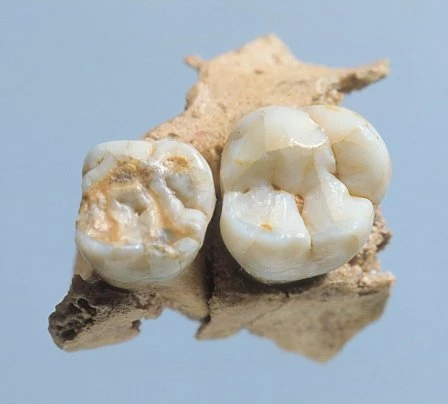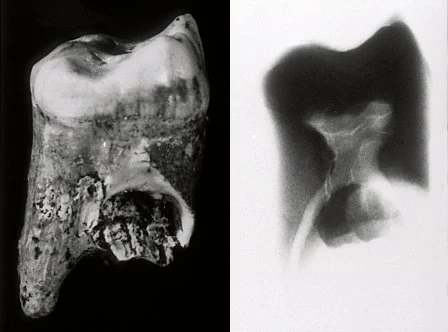The oldest people in Wales - Neanderthal teeth from Pontnewydd Cave
Reconstruction painting showing Early Neanderthal Man.
Upper jaw of a child aged around 9 years old.
Early Neanderthal tooth (left), and X-ray (right). The X-ray show the enlarged pulp cavity that has helped archaeologists to identify the Pontnewydd teeth as belonging to Neanderthals.
Pontnewydd Cave was excavated by Amgueddfa Cymru between 1978 and 1995. The wall that can be seen across the entrance to the cave was built during the Second World War, at which time Pontnewydd Cave served as a munitions store.
Pontnewydd Cave
Excavations at Pontnewydd Cave, Denbighshire have discovered the oldest human remains known from Wales dating back some 230,000 years.
Excavations at the cave by Amgueddfa Cymru between 1978 and 1995 unearthed a total of
19 teeth , discovered found deep inside the cave. These have been identified by experts at the Natural History Museum, London as belonging to an early form of Neanderthal.Neanderthals in Wales
Neanderthals are one branch of the human evolutionary tree that is thought to have died out approximately 36,000 years ago. Our own species shared a common ancestor with Neanderthals, but did not evolve from them.
Neanderthals were fairly short and stocky, had ridges under their eyebrows, big square jaws, and teeth that are larger than ours are today.
Study of the remains found at Pontnewydd found that these teeth represent the remains of at least five individuals.
Neanderthal Teeth
The teeth have all been x-rayed and they show an interesting characteristic known as taurodontism - an enlarged pulp cavity to the teeth and shorter roots. Taurodontism is a characteristic (although not unique) feature of Neanderthal teeth and it is one of the features that has led experts to decide that these are Neanderthal as opposed to another early human.
The people discovered in Pontnewydd Cave range in age from
young children to adults. The most complete discovery from the site is a fragment of an upper jaw of a child aged around nine years old. In the jaw a very heavily worn milk tooth can be seen sitting next to a newly erupted permanent molar.Food remains
The teeth were not found on their own inside the cave. Alongside them were
stone tools and animal bones , some of which show signs of butchery - evidence that these were the food remains of these early Neanderthals.Questions remain as to whether these humans were originally buried in graves within the cave. The cave has since been washed through by the melt water from the retreating ice sheets at the end of the last Ice Age. Unfortunately the forces that have remarkably led to the preservation of these teeth deep within Pontnewydd Cave destroyed any traces of their original burial context.
Background Reading
Ice Age hunters: neanderthals and early modern hunters in Wales by S. Green and E. Walker Published by the National Museum of Wales (1991).
In search of the neanderthals: solving the puzzle of human origins by C. Stringer and C. Gamble. Published by Thames and Hudson (1993).
Pontnewydd Cave: a lower Palaeolithic hominid site in Wales: the first report by H. S. Green. Published by the National Museum of Wales (1984).
Neanderthals in Wales: Pontnewydd and the Elwy Valley Caves edited by Stephen Aldhouse-Green, Rick Peterson and Elizabeth A. Walker. Published by National Museum Wales Books and Oxbow Books (2012).




Comments - (3)
Hi Zara,
Thank you for getting in touch with us. This place is called Pontnewydd Cave, and is located near St Asaph, which is a city in Denbighshire, North Wales. I hope you're enjoying the study!
Kind regards,
Nia
(Digital team)